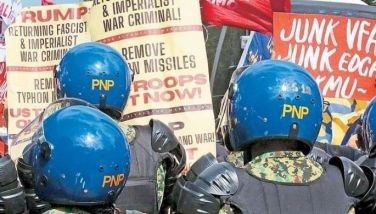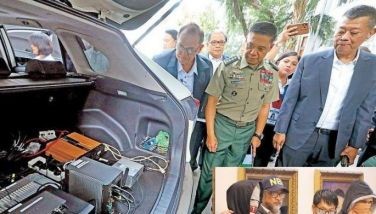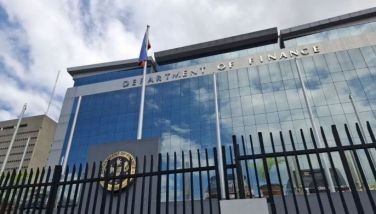PCIJ report: Top US contractor squatting at Clark
July 2, 2001 | 12:00am
(First of two parts) |
Lockheed Martin told the Philippine Center for Investigative Journalism (PCIJ) its Aircraft Service Center "is in the process of advance implementation," supposedly as counter-trade for its sale to the Philippine Air Force of four, 30-year-old C-130-K military transport and cargo planes and two sensor equipment for $41 million (P2.1 billion).
The negotiated C-130 deal is still undergoing review by the National Economic and Development Authority (NEDA) board chaired by President Arroyo. But Lockheed Martin and its local partner, Asian Aerospace Corp., have already moved equipment and personnel to Clark.
"They’re acting as if they have a deal," Budget Secretary Emilia Boncodin said in an interview with the PCIJ. "The fact that they are there means there is a meeting of the minds already but there is none. What are they doing there?"
Boncodin said that in Malacañang last week, Mrs. Arroyo had told Cabinet members that "the (C-130s) project may be good but it has some problems and we cannot take action yet."
Rival contractors are also up in arms over Lockheed’s premature presence at Clark. Military insiders and contractors alike say as well that given the long history of questionable procurement deals in the Armed Forces, it could well be that what has taken place so far regarding the contract is a portent of how the modernization program of the Armed Forces of the Philippines could be circumvented in the future.
Launched in 1996, the AFP modernization program was intended to raise the military’s capability to meet both internal and external security threats.
Its implementing rules prescribe that the AFP must purchase directly from manufacturers, and only through public bidding. The law also binds the winning bidders to do "reciprocal trade" or deliver or purchase goods and services from the Philippines, in the amount equivalent to the contract they’ve been awarded.
A 15-year program, it has a total of P150 billion, of which P10 billion is to be awarded this year.
Former Defense Secretary Orlando Mercado said that because the modernization program involves big money, "everybody is salivating over these contracts."
Indeed, some contractors are already complaining about what they said are the cozy ties that allegedly bind Lockheed and the Air Force top brass, which agreed under the supply contract to grant the major US defense contractor virtual monopoly over repair services for all planes in the Air Force fleet.
This will entail cancellation of existing service deals with other, smaller contractors, including those covered by proper contracts that have not expired.
The repairs to be done at Clark facility would allow Lockheed Martin an inside track into purchases to be made under the modernization program, said contractors.
"The Air Force just openly gave them the facility of the Air Force City in Clark," said Alberto Filart, executive vice president of Jet Ventures Philippines, which had been contacted earlier by the Air Force for repair of its OV-10B Bronco, a ground attack aircraft.
"Lockheed can very well afford to put up their facility. Why were they the ones given that kind of privilege, while we, a local start-up, composed of OCWs (overseas contract workers), were discriminated against," said Filart, who stands to lose his OV-10 service contract to Lockheed.
Recently, Filart wrote to Mrs. Arroyo herself to ask: "Why are we giving away these opportunities to foreign companies, especially at the expense of the local companies?"
Five people who assisted Lockheed Martin’s flight to Clark may have the answers: former President Fidel Ramos, ousted President Joseph Estrada, two of Estrada’s closest military officers, then Armed Forces chief of staff Gen. Angelo Reyes, and Air Force chief, Lt. Gen. Benjamin Defensor and Estrada’s Executive Secretary Ronaldo Zamora.
It was Reyes – now the defense secretary – and Defensor who signed, without public bidding, the contract to buy the four C-130-K planes. The 29-page "memorandum of agreement" and supply contract bears the date Feb. 28, 2001, or a month after the Arroyo administration came to power.
Without the C-130 contract, there is no reason for Lockheed to be establishing a repair facility in Clark as counter-trade. Interestingly enough, the contract itself has no counter-trade provisions.
Yet Asian Aerospace president Peter Rodriguez, Lockheed Martin corporate consultant in the Philippines, said, "Lockheed and Asian Aerospace were very sincere, even before we consummated the deal for the C-130, nag-counter-trade na."
In separate interviews, Reyes and Defensor said Estrada had issued in late 2000 a memorandum authorizing the negotiated C-130 deal. They said Estrada wanted to do away with the tedious bidding process that stretches from six months to two years. It was, they said, supposed to be an "interim" purchase and therefore would not fall under the modernization program. The funds for it were supposed to come from a loan from the US Export-Import Bank that Lockheed Martin arranged.
Reyes said he endorsed approval of the contract, on Defensor’s recommendation and after "rigorous study" by his staff in an October 2000 letter to Estrada, through then Executive Secretary Zamora.
But Rodriguez said that it was Ramos who first made a commitment, albeit informally, to award the C-130 deal and Aircraft Service Center to Lockheed.
According to Rodriguez, Ramos in 1996 at the Waldorf Astoria in New York, "witnessed the signing of a memorandum of understanding" between Lockheed and Asia Aerospace "for the establishment of an Aircraft Service Center offer of Lockheed Martin for the proposed C-130 Interim Long Range Patrol Aircraft Program for the Philippine Air Force."
Rodriguez is known in defense industry circles as close to Ramos. The head office of Asian Aerospace firm is based in Pangasinan, Ramos’ home province.
Curiously, though, the idea that the Air Force needed Long Range Patrol Aircraft did not come about until after 1998, when the Armed Forces finalized its priorities list for modernization. In May 1996, too, Asian Aerospace and Lockheed Martin Tactical System Division signed a memorandum of understanding with the Air Force for a "Philippine Air/Sea Surveillance System," and "the possible acquisition of F-16 fighter aircraft," and not C-130 planes.
All that the US firm had discussed with the Clark Development Corp. is the possible "rental" of two existing hangars, "lease" of office space and use of Clark’s two 12,000-foot runways. No contract for his has been signed.
Rodriguez did say, however, that the firm’s lawyers are still working on lease agreement contracts for the Aircraft Service Center that he said was Lockheed Martin’s counter-trade offer for the C-130 contract. He said that the firm acknowledges that the C-130 contract is not a done deal.
Still, Rodriguez said that under the C-130 deal, Lockheed Martin will build seven hangars each measuring 5,000 square meters, and secure access to a hectare of open space, to house up to four C-130 planes and 20 helicopters for repair services. The firm plans to open the Aircraft Service Center for use, too, he said.
Not all those who must review defense contracts were apparently brought into the loop regarding the C-130s contract. The deal was kept secret even to then Defense Secretary Mercado, who had insisted on public, electronic bidding of all military purchases, consistent with the strict rules of the AFP Modernization Law.
"Nothing passed my office. This is a reprise of previous deals I’ve rejected," said Mercado, who had earlier thumbed down two negotiated contracts approved by the Armed Forces top brass, including one for the purchase of helicopter gunships from Asian Aerospace.
"It’s probably one of those midnight deals," he said. "That’s their style, they’re dismantling and cannibalizing the AFP modernization program."
A Cabinet secretary now reports, however, that the C-130s contract is now in limbo, because of an Arroyo order requiring NEDA board review of contracts worth at least P50 million.
The National Security Council, which had undertaken a review of a white paper that had been circulating within the government agencies in May, has proposed to reject the C-130 deal. In a May 25 memo, the Council said "the contract may be viewed as grossly disadvantageous to the Philippine government by certain members of the opposition and media, and used to disprove or refute the avowed goals of good governance of the Arroyo administration."
The contract had been signed a day after President Arroyo met in Malacañang with Robert Young, "president of the United States-based Lockheed Martin," according to a press release dated March 1, from the Office of the Press Secretary.
Young, the release said, "told the President that his company is putting up an Aircraft Service Center inside the sprawling Clark Air Base in Pampanga, in partnership with Asian Aerospace Corp. represented by President/CEO Rodriguez."
Mrs. Arroyo in turn told Young, "You would be able to help a lot of my kabalens (provincemates) there with your investments."
Young signed the document as a witness, while John R. Bergquist signed for the Lockheed Martin Overseas Corp. (LMOC) as "contract officer" and Rodriguez, for Asian Aerospace.
The Palace press release made it seem that the two men signed the contract as official representatives of Lockheed Martin. But a search on the website of Lockheed Martin Corp. and its affiliate companies did not yield their names. Lockheed Martin, in response to a questionnaire from PCIJ, said the three are authorized representatives of the firm.
But contrary to the provisions of the Modernization Law, the contract involved not the manufacturer, Lockheed Martin Corp., but a "distributor," according to the company itself.
In 1999, Lockheed Martin informed the US Securities and Exchange Commission that it was allowing consultants to negotiate contracts for the company but that all contracts signed by consultants will be in the name of the LMOC.
"An individual or firm that purchases products for resale is a distributor, rather than a consultant," said Lockheed Martin. The LMOC and Asian Aerospace are reselling the four C-130s to the Philippines from the Royal Air Force (RAF) of the United Kingdom.
In separate interviews, Reyes and Defensor said the contract is a bargain that responds to the urgent needs of the Air Force for enhanced cargo airlift and surveillance capabilities.
Reyes said that the upsides to the deal are that Lockheed would put up an "Aircraft Service Center" at the Air Force hangar on Clark Air Airbase, invest $50 million, transfer technology to Filipino aircraft technicians and create 1,000 new jobs.
The four planes will cost $12 million, and two sensors, $6 million, but the bulk of the $41-million project cost will go to software, engineering services, peripherals and "project management" fees. A brand-new C-130 plane costs $81 million, Lockheed Martin said.
"We thought it was a good deal. We think it is a good deal," Reyes said. But he also said that since the contract has not been consummated, "they could even cancel it if they want."
"This was an arrangement made between Lockheed and the Philippine government which was approved by the previous administration and pursued by the present administration simply because of the good benefits that will come out of it," Defensor said. "The offer is really very attractive because they are offering C-130s for a very minimal price."
"I personally went there (Lockheed yard in Delaware, US)... in my capacity as CG (commanding general) of the PAF to see if this aircraft is true because I could not believe it, that that aircraft could be given away at that price," he added. "As a matter of fact, we even had coffee inside the aircraft, in much better shape than our C-130s now." He had coffee with Lockheed’s Rodriguez.
An internal Air Force study in 1999 said that while the C-130 has proved "very reliable" as the Air Force’s "workhorse," the second-hand C-130s are costly to operate and maintain, compared to nine other Long-Range Patrol Aircraft options.
A day-long sortie of the four-engine C-130 would cost nearly P1 million in aviation fuel alone.
Moreover, the study said that two years ago, the same contractor had offered the same four planes for $35 million, cheaper than the $41 million for which the Air Force is now buying them.
But Budget Secretary Boncodin said that even if the negotiated contract could be justified because Lockheed Martin is the sole manufacturer of the C-130 Hercules plane, the key issue is that the deal is not covered by any appropriations from Congress. The Defense department’s budgets for 2000 and 2001 have zero appropriation for Capital Outlay because all the funds have been put under the modernization program.
If the C-130 deal should be covered at all, the funding should come from the modernization fund, she said. That implies, however, that the contract will have to be subjected to the strict rules on public bidding of the AFP Modernization Law.
But on her birthday last April 5, Mrs. Arroyo and her Cabinet members attended the "soft launch" of the Lockheed Martin "Aircraft Service Center" at Clark. A Cabinet secretary said Mrs. Arroyo even opened a champagne bottle during the ceremony in what looked like a new facility because it had a fresh coat of paint.
Two months later, Boncodin and the NEDA board have yet to see and approve the alleged contract that would render the project legal and binding. – With additional reporting by Luz Rimban.
BrandSpace Articles
<
>
- Latest
- Trending
Trending
Latest
Trending
Latest
Recommended
January 21, 2025 - 12:00am
January 18, 2025 - 12:00am




























